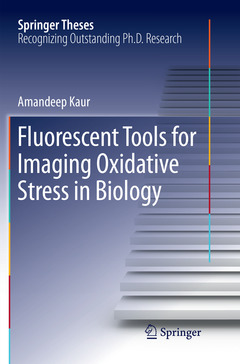Fluorescent Tools for Imaging Oxidative Stress in Biology, 1st ed. 2018 Springer Theses Series

This thesis advances the long-standing challenge of measuring oxidative stress and deciphering its underlying mechanisms, and also outlines the advantages and limitations of existing design strategies. It presents a range of approaches for the chemical synthesis of fluorescent probes that detect reversible changes in cellular oxidative stress. The ability to visualise cellular processes in real-time is crucial to understanding disease development and streamline treatment, and this can be achieved using fluorescent tools that can sense reversible disturbances in cellular environments during pathogenesis. The perturbations in cellular redox state are of particular current interest in medical research, since oxidative stress is implicated in the pathogenesis of a number of diseases.
The book investigates different strategies used to achieve ratiometric fluorescence output of the reversible redox probes, which nullify concentration effects associated with intensity-based probes. It also describes suitable approaches to target these probes to specific cellular organelles, thereby enabling medical researchers to visualise sub-cellular oxidative stress levels, and addressing the typically poor uptake of chemical tools into biological studies.In total it reports on four new probes that are now being used by over twenty research groups around the globe, and two of which have been commercialised. The final chapters of this thesis demonstrate successful applications of the sensors in a variety of biological systems ranging from prokaryotes to mammalian cells and whole organisms. The results described clearly indicate the immense value of collaborative, cross-disciplinary research.
Amandeep Kaur completed her master’s studies in chemistry, with a University medal from VIT University, India in 2012. She then took up a research internship at ENSCCF, France, where she worked on the development of transition metal-doped calcium phosphate ceramics. Amandeep completed her Ph.D. in 2016 at the University of Sydney with Dr Elizabeth New, during which she was awarded a World Scholars Scholarship. Her Ph.D. research involved the development of reversible fluorescent redox sensors for understanding the role of oxidative stress in biological systems. She is currently working as a postdoctoral research fellow at the EMBL Australia Node in Single Molecule Science, University of New South Wales, Australia.
Date de parution : 12-2018
Ouvrage de 230 p.
15.5x23.5 cm
Date de parution : 03-2018
Ouvrage de 230 p.
15.5x23.5 cm



